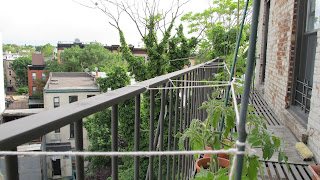I'm heading to Barbados for the next week and will share all my tropical adventures when I get back!
Saturday, June 18, 2011
Opuntia humifusa
Last summer when I took Herbaceous Plant Identification at the Brooklyn Botanic Garden I was shocked how some of our native to New York plants could be so tropical looking! For instance, the Sarracenia sp., or Pitcher Plant, are carnivorous plants that live in boggy/moist areas and seem better suited to the Amazon then to Eastern North America.
Opuntia humifusa, or Prickly Pear, is another example of a tropical-looking plant that is native to New York. It's a cactus and I am lucky to have one blooming right now! It has these wide, flat "modified stems" that lay down and shrivel during the winter. Here is the Prickly Pear at the BBG during the winter. It looks like the whole plant has seen better days and you better chuck it.
But wait! In the spring, the large stems swell with water and perk back up. Here is mine, perky and verdant about a month ago.
I suggest everyone go out and buy an Opuntia humifusa!
Opuntia humifusa, or Prickly Pear, is another example of a tropical-looking plant that is native to New York. It's a cactus and I am lucky to have one blooming right now! It has these wide, flat "modified stems" that lay down and shrivel during the winter. Here is the Prickly Pear at the BBG during the winter. It looks like the whole plant has seen better days and you better chuck it.
But wait! In the spring, the large stems swell with water and perk back up. Here is mine, perky and verdant about a month ago.
These are the flower buds starting to form.
And now! Ta-da!
Large, bright, lemony-yellow flowers. Absolutely beautiful! Here is the one at the BBG. Winter vs. Summer. I suggest everyone go out and buy an Opuntia humifusa!
Wednesday, June 8, 2011
Basil-Cilantro Pesto
My friend Reilly recently harvested a bountiful amount of fresh basil and cilantro from his fire escape garden and wasn't sure what to do with all of it. I thought what better way to use these fragrant, fresh herbs than to make pesto!

To make this pesto recipe you will need a large handful of basil, an equally large handful of cilantro, half a lemon, two to three garlic gloves (depending on your love of garlic), sliced almonds, olive oil, and salt. Also, a very sharp knife and cutting board. We are doing this by hand people! First, make a small pile in the middle of your cutting board with about a quarter of your basil and cilantro.
Typically, when Italians make pesto by hand they use a tool called a mezzaluna, or half moon. This tool allows you to rock back and forth, easily slicing through your herbs. However, if you're like me, and don't have a mezzaluna, you can replicate this motion with your knife.

When you've thoroughly chopped half the amount of basil and cilantro, put your garlic cloves on top of your pesto pile and continue the rocking motion of your knife to incorporate. Then, sprinkle about 1/3 cup of slice almonds on your freshly sliced mound.
Making pesto by hand is a lot harder and more time consuming then just throwing your ingredients in a food processer, but the aroma you get from thinly slicing the herbs yourself is worth the sweat and calluses. When you have thoroughly incorporated your almonds and garlic cloves try to create a little pesto ball with your hands.
If it stays clumped and upright in a tight mound, then the consistency is perfect!
Transfer your mound to a small bowl and drizzle with olive oil, lemon, and salt to taste. Spread on a piece of good bread and enjoy with friends! Here's Reilly chowin' down :)
Other classic pesto combinations are basil/pine nuts/parmesan cheese, peas/parmesan cheese/garlic, arugula/pistachio/garlic, and cilantro/jalapenos/pine nuts. All delicious!
Sunday, June 5, 2011
Green Tomatoes
My little sister's favorite movie is Fried Green Tomatoes and it's all I can think about as I stare at my slowly growing, green tomato, resisting the urge to pluck it and fry it. I know it will be better juicy and red in a caprese salad, but I'm getting impatient for some scrumptious summer tomatoes. Isn't it a beauty?
And flanking it on either side are two baby tomatoes.
The other plants nearby are flowering as well and these little yellow flowers will hopefully get pollinated and become new tomatoes! Tip: If you are growing tomatoes indoors, try to gently shake the plant's stem so that it will self-pollinate since wind and insects won't be doing the job.
So far the tomatoes have been loving their sunny Brooklyn fire escape. However, it can get a little windy since it is on the top floor and some of the stakes were starting to blow over. My crafty boyfriend came up with a brilliant solution to tie the top of the stakes to the fire escape's railing, which has worked out perfectly!
Sun. Check.
Rope contraption to stabilize plants. Check.
Yellow Flowers. Check
3 baby tomatoes. Check
We are well on our way to having a plethora of juicy, red, organic heirloom tomatoes come July. Can't wait!
Thursday, June 2, 2011
Baby Tomato
I HAVE A TOMATO! It's small and green, but IT'S A TOMATO!
I'll share more pictures this weekend because there are about four more baby tomatoes popping out.
I'll share more pictures this weekend because there are about four more baby tomatoes popping out.
Subscribe to:
Comments (Atom)





















